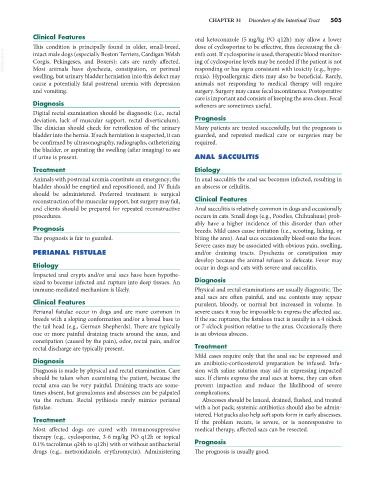Page 533 - Small Animal Internal Medicine, 6th Edition
P. 533
CHAPTER 31 Disorders of the Intestinal Tract 505
Clinical Features oral ketoconazole (5 mg/kg PO q12h) may allow a lower
This condition is principally found in older, small-breed, dose of cyclosporine to be effective, thus decreasing the cli-
VetBooks.ir intact male dogs (especially Boston Terriers, Cardigan Welsh ent’s cost. If cyclosporine is used, therapeutic blood monitor-
ing of cyclosporine levels may be needed if the patient is not
Corgis, Pekingeses, and Boxers); cats are rarely affected.
Most animals have dyschezia, constipation, or perineal
rexia). Hypoallergenic diets may also be beneficial. Rarely,
swelling, but urinary bladder herniation into this defect may responding or has signs consistent with toxicity (e.g., hypo-
cause a potentially fatal postrenal uremia with depression animals not responding to medical therapy will require
and vomiting. surgery. Surgery may cause fecal incontinence. Postoperative
care is important and consists of keeping the area clean. Fecal
Diagnosis softeners are sometimes useful.
Digital rectal examination should be diagnostic (i.e., rectal
deviation, lack of muscular support, rectal diverticulum). Prognosis
The clinician should check for retroflexion of the urinary Many patients are treated successfully, but the prognosis is
bladder into the hernia. If such herniation is suspected, it can guarded, and repeated medical care or surgeries may be
be confirmed by ultrasonography, radiographs, catheterizing required.
the bladder, or aspirating the swelling (after imaging) to see
if urine is present. ANAL SACCULITIS
Treatment Etiology
Animals with postrenal uremia constitute an emergency; the In anal sacculitis the anal sac becomes infected, resulting in
bladder should be emptied and repositioned, and IV fluids an abscess or cellulitis.
should be administered. Preferred treatment is surgical
reconstruction of the muscular support, but surgery may fail, Clinical Features
and clients should be prepared for repeated reconstructive Anal sacculitis is relatively common in dogs and occasionally
procedures. occurs in cats. Small dogs (e.g., Poodles, Chihuahuas) prob-
ably have a higher incidence of this disorder than other
Prognosis breeds. Mild cases cause irritation (i.e., scooting, licking, or
The prognosis is fair to guarded. biting the area). Anal sacs occasionally bleed onto the feces.
Severe cases may be associated with obvious pain, swelling,
PERIANAL FISTULAE and/or draining tracts. Dyschezia or constipation may
develop because the animal refuses to defecate. Fever may
Etiology occur in dogs and cats with severe anal sacculitis.
Impacted anal crypts and/or anal sacs have been hypothe-
sized to become infected and rupture into deep tissues. An Diagnosis
immune-mediated mechanism is likely. Physical and rectal examinations are usually diagnostic. The
anal sacs are often painful, and sac contents may appear
Clinical Features purulent, bloody, or normal but increased in volume. In
Perianal fistulae occur in dogs and are more common in severe cases it may be impossible to express the affected sac.
breeds with a sloping conformation and/or a broad base to If the sac ruptures, the fistulous tract is usually in a 4 o’clock
the tail head (e.g., German Shepherds). There are typically or 7 o’clock position relative to the anus. Occasionally there
one or more painful draining tracts around the anus, and is an obvious abscess.
constipation (caused by the pain), odor, rectal pain, and/or
rectal discharge are typically present. Treatment
Mild cases require only that the anal sac be expressed and
Diagnosis an antibiotic-corticosteroid preparation be infused. Infu-
Diagnosis is made by physical and rectal examination. Care sion with saline solution may aid in expressing impacted
should be taken when examining the patient, because the sacs. If clients express the anal sacs at home, they can often
rectal area can be very painful. Draining tracts are some- prevent impaction and reduce the likelihood of severe
times absent, but granulomas and abscesses can be palpated complications.
via the rectum. Rectal pythiosis rarely mimics perianal Abscesses should be lanced, drained, flushed, and treated
fistulae. with a hot pack; systemic antibiotics should also be admin-
istered. Hot packs also help soft spots form in early abscesses.
Treatment If the problem recurs, is severe, or is nonresponsive to
Most affected dogs are cured with immunosuppressive medical therapy, affected sacs can be resected.
therapy (e.g., cyclosporine, 3-6 mg/kg PO q12h or topical
0.1% tacrolimus q24h to q12h) with or without antibacterial Prognosis
drugs (e.g., metronidazole, erythromycin). Administering The prognosis is usually good.

